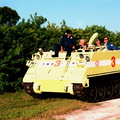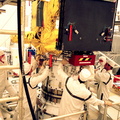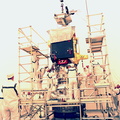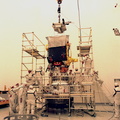
WIKIARCHIVES.SPACE
The Human Spaceflight Archive

Information
- Taken in
- Kennedy Space Center
- Author
- NASA
- Description
- Workers in the Defense Satellite Communications Systems Processing Facility (DPF) at Cape Canaveral Air Station (CCAS) finish installing the ion propulsion engine on Deep Space 1. The first flight in NASA's New Millennium Program, Deep Space 1 is designed to validate 12 new technologies for scientific space missions of the next century, including the engine. Propelled by the gas xenon, the engine is being flight-tested for future deep space and Earth-orbiting missions. Deceptively powerful, the ion drive emits only an eerie blue glow as ionized atoms of xenon are pushed out of the engine. While slow to pick up speed, over the long haul it can deliver 10 times as much thrust per pound of fuel as liquid or solid fuel rockets. Other onboard experiments include software that tracks celestial bodies so the spacecraft can make its own navigation decisions without the intervention of ground controllers. Deep Space 1 will complete most of its mission objectives within the first two months, but will also do a flyby of a near-Earth asteroid, 1992 KD, in July 1999. Deep Space 1 will be launched Oct. 25 aboard a Boeing Delta 7326 rocket from Launch Pad 17A, CCAS.
- Created on
- Wednesday 7 October 1998
- Source link
- https://science.ksc.nasa.gov/gallery/photos/1998/captions/KSC-98PC-1265.html
- Visits
- 45
- Rating score
- no rate
- Rate this photo
- License
- CC BY-NC
- Modified by WikiArchives
- No (original)
- Downloads
- 3
Powered by Piwigo















